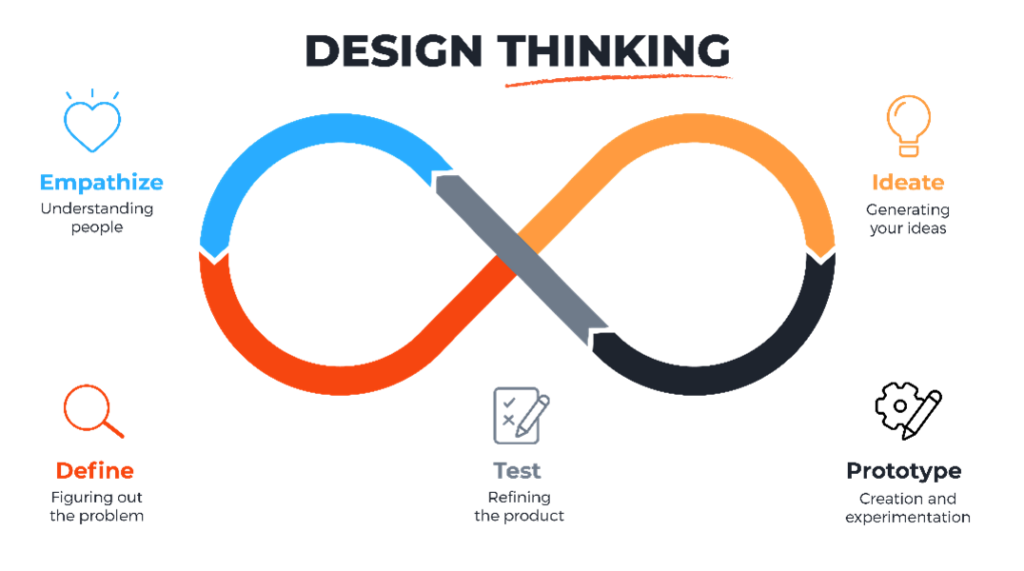
In today’s fast-paced and dynamic business environment, innovation is the key to staying ahead of the competition. “Design Thinking” has become notably prominent, in the sphere of business innovation, in recent years.
Design Thinking is a mindset that anyone can adopt to solve complex problems and create innovative solutions.
At its core, Design Thinking involves empathizing with end-users, defining problems, ideating, prototyping, and testing solutions.
This iterative process allows businesses to uncover unique insights and develop products and services that truly resonate with their target audience.
Going beyond conventional approaches to problem-solving, this human-centred methodology taps into creativity as a driving force for innovation in the business landscape
The Design Thinking Process:
Empathize: The first step is understanding the needs and perspectives of your audience. This involves conducting interviews, surveys, and observations to gain deep insights into their experiences.
Define: Clearly articulate the problem you are trying to solve based on the information gathered during the empathy phase. This step sets the foundation for the rest of the process.
Ideate: Encourage creative thinking and brainstorming sessions to generate a wide range of possible solutions. This is the stage where diverse perspectives lead to innovative ideas.

Prototype: Develop tangible representations of your ideas to quickly test and gather feedback. This step helps in refining and improving concepts before investing significant resources.
Test: Put your prototypes to the test with the target audience. Gather feedback, iterate on the designs, and refine the solutions based on real-world insights.
Design Thinking brings about customer-centric solutions by placing a strong emphasis on empathy, ensuring that the needs and preferences of end-users take precedence in the innovation process. This approach not only prioritizes understanding the user’s perspective but also fosters enhanced creativity within teams. The collaborative and iterative nature of Design Thinking cultivates a culture where teams can think outside the box, resulting in innovative solutions that resonate with the target audience. Design Thinking serves as a robust tool for risk mitigation in the business landscape. Through early-stage prototyping and testing, businesses can proactively identify and address potential issues before committing to full-scale implementation. This proactive approach significantly reduces the risk of failure, allowing organizations to refine and optimize their solutions based on real-world insights. Additionally, the application of Design Thinking translates into increased efficiency within business processes enabling organizations to streamline their operations and optimize workflows.
You may also be interested in reading: Innovation through Empathy: Applying Design Thinking in Management Practices
Design Sprints:
A valuable addition to the Design Thinking toolkit is the concept of Design Sprints. A Design Sprint is a time-boxed, intensive process that compresses the Design Thinking stages into a short timeframe, usually five days. Developed by Google Ventures, Design Sprints are particularly effective for rapidly solving complex problems and testing innovative ideas.

Design Sprints involve cross-functional teams collaborating intensely over a short period, aligning with the collaborative and iterative nature of Design Thinking.
By condensing the process into a focused timeframe, Design Sprints enable businesses to accelerate innovation without sacrificing the depth of understanding gained through empathetic exploration.
Illustrating Transformation through Statistics:
The collaborative and iterative nature of Design Thinking translates into a statistical boost in creativity within teams. Research indicates that teams employing Design Thinking principles generate a 46% higher rate of innovative ideas compared to traditional problem-solving methods. These statistics paint a compelling picture of how fostering a culture of creativity through Design Thinking can significantly elevate the innovative potential of a business.

In terms of risk mitigation, statistics further emphasize the effectiveness of Design Thinking. Businesses that invest in early-stage prototyping and testing experience a 32% reduction in the likelihood of project failure. This not only underscores the power of Design Thinking in identifying and addressing potential issues before full-scale implementation but also quantifies the risk reduction it brings to the table. Furthermore, organizations adopting this methodology witness a 28% increase in operational efficiency.
You may also be interested in reading: Innovative Careers of the Future
Implementing Design Thinking in Your Business:
- Foster a Culture of Innovation: Encourage a mindset shift within your organization, emphasizing the importance of creativity and continuous improvement.
- Invest in Training: Provide your team with the necessary training and resources to understand and apply Design Thinking principles effectively.
- Establish Cross-Functional Teams: Bring together individuals from different departments to ensure diverse perspectives are considered throughout the innovation process.
Design Thinking is a powerful approach to drive innovation in business by putting the customer at the centre of the creative process. Embracing this methodology can lead to breakthrough solutions, increased customer satisfaction, and a competitive edge in the market. By integrating Design Thinking into your organization’s DNA, you’re not just solving problems – you’re transforming the way your business innovates and thrives in the ever-evolving landscape.
The MBA in Global Business Administration with Applied Entrepreneurship, Design Thinking and Innovation offered by Westford Uni Online, focuses on innovative and entrepreneurial theories in the realm of design thinking. This program is crafted to meet present-day market and professional requirements.
References
- Bender-Salazar, R. (2023). ‘Design thinking as an effective method for problem-setting and needfinding for entrepreneurial teams addressing wicked problems.’ Journal of Innovation and Entrepreneurship, 12, 24. https://doi.org/10.1186/s13731-023-00291-2 (Accessed: 06/02/2024).
- Design Management Institute. (2015). ‘2015 dmi:Design Value Index Results and Commentary.’ Available at: https://www.dmi.org/page/2015DVIandOTW (Accessed: 06/02/2024).
- McKinsey & Company. (2023). What is Design Thinking. Available at: https://www.mckinsey.com/featured-insights/mckinsey-explainers/what-is-design-thinking (Accessed: 06/02/2024).





